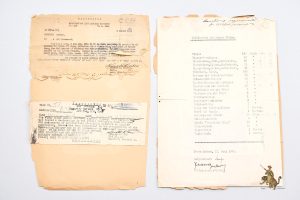$225.00
Condition: Excellent
In stock
Product Description: A scarce and evocative Luftschiff Hindenburg Stationery Page, measuring approximately 8 x 11 inches. The sheet displays gentle toning and a light waviness consistent with age and preservation. Bearing the original printed letterhead, which roughly translates to “Airship Hindenburg, On Board, German Zeppelin Shipping Company,” this piece offers a tangible connection to one of the most iconic airships of the early 20th century. A rare surviving artifact of pre-war transatlantic aviation, notable for its historical resonance and fine state of preservation.
Historical Description: The Hindenburg Zeppelin, officially designated LZ 129 Hindenburg, was a German passenger airship and one of the most famous dirigibles ever built. Constructed by the Zeppelin Company under the direction of Dr. Hugo Eckener, it represented the pinnacle of rigid airship design in the 1930s—a symbol of both technological ambition and national pride in pre–World War II Germany.
Launched on March 4, 1936, the Hindenburg was named in honor of Paul von Hindenburg, the former President of Germany. It measured an astonishing 804 feet (245 meters) in length, making it longer than the Titanic, and was filled with hydrogen, a highly flammable gas used in place of nonflammable helium, which was unavailable to Germany due to U.S. export restrictions.
The airship was powered by four Daimler-Benz diesel engines and could cruise at about 76 miles per hour (122 km/h), carrying up to 50 passengers and 60 crew members across the Atlantic in remarkable comfort. Its interior was lavishly designed, featuring dining rooms, lounges, promenades with panoramic windows, and even a smoking room—an audacious inclusion given the hydrogen fuel.
During its service in 1936–1937, the Hindenburg made 63 successful flights, including regular transatlantic service between Germany and the United States or South America. It embodied both modern luxury travel and the prestige of German engineering.
Tragically, the Hindenburg’s story ended in disaster on May 6, 1937, when it caught fire while attempting to land at Lakehurst Naval Air Station in New Jersey. Within seconds, the airship was consumed by flames, killing 36 of the 97 people on board and one ground crew member. The event, captured in photographs and dramatic radio broadcasts, marked the end of the airship era.
Today, the Hindenburg remains a powerful symbol—both of human innovation at its most ambitious and of the risks inherent in technological overreach.
We are the leading team of military antique specialists. We have specialized in military antiques for over 25 years.
Epic Artifacts offers the highest prices available for your collectibles.
We purchase single items, entire collections, or family estates.
Click the link here to learn more: Inquiries
or feel free to email us directly: info@epicartifacts.com

In stock

In stock

In stock

In stock